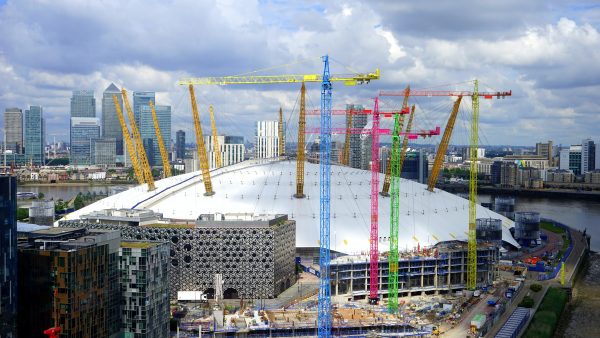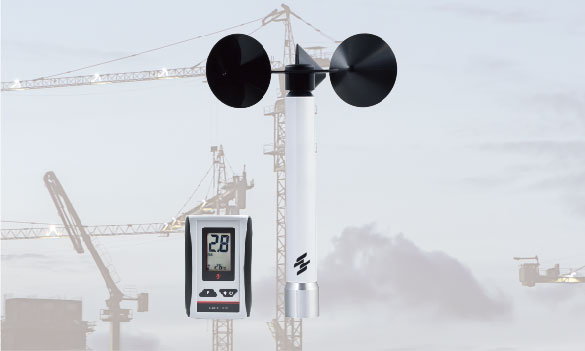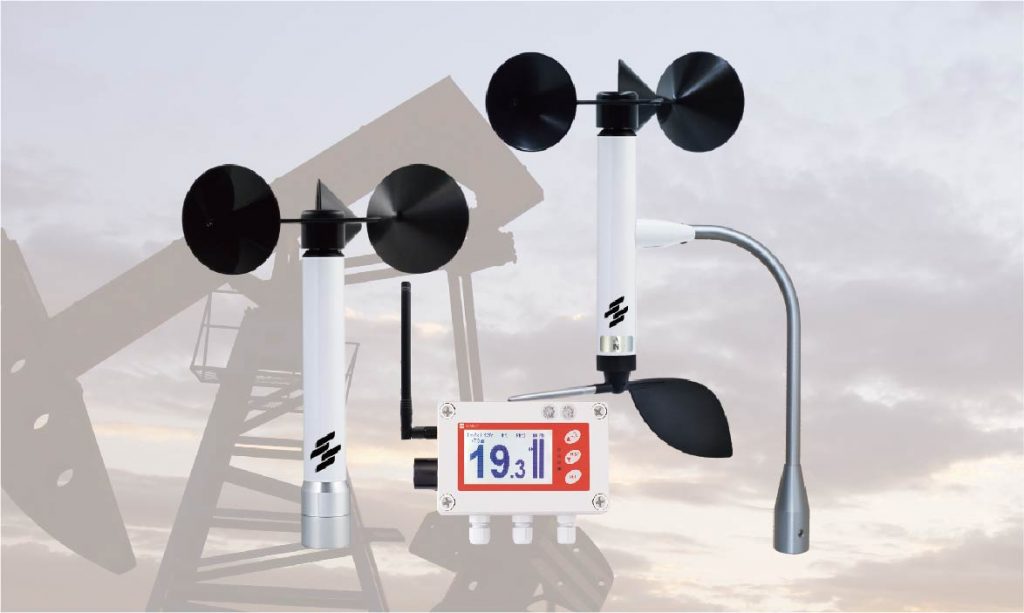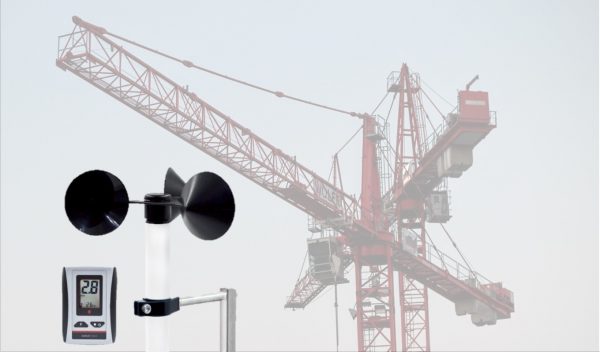Know How –
How Does Wind Influence Crane Safety?
Do you know the fact that wind is the second most common cause for crane accidents worldwide? Surprising right! According to the American National Standards Institute (ANSI), there were 1,125 tower crane accidents reported worldwide between 2000 and 2010, resulting in more than 780 deaths. Exposure to wind was one of the main factors causing these tragedies, which account to 23% of all accidents.
Wind conditions may pose certain risk bringing potential hazards to crane operation that should not be overlooked. It is crucial for crane operators to check and monitor wind conditions before and throughout crane operation.

The Basics of Wind & Wind Gusts
Wind is moving air, the flow of air moves from the higher pressure areas to the lower pressure areas due to changes on atmospheric pressure and temperature. Wind speed is measured at 33 feet (±10 meters) above the ground and it increases with height, the higher the height, the stronger the wind speed. Another characteristic of wind speed is it increases with pressure as well, the stronger the wind speed, the stronger the pressure.
In addition, not many people know that another underestimated factor of accidents is wind gusts. Wind gusts is a sudden strong flurry of wind that is active within a wind or storm. Gusts can be very dangerous as they occur suddenly and hard to predict. Gusts happen in a relatively short period of time, the problem here is not the duration but rather the sudden appearance of a much stronger air movement than the rest of the wind that one least expected. Thus gusts can be a bigger problem than the wind itself.
Some external factors that can increase or decrease the wind gust speed includes:
- Buildings and structures
- Height above ground
- Narrow valleys and gutters
- Smooth water surfaces
How Wind Affects Crane operation?
Wind affects crane stability and load movement and control issues. Wind speed generally increases along as height increases. An increase of wind speed can have a significant effect on the safe operation of the crane. How? wind applies forces directly to the crane and load, when wind pressures or forces exerts on crane load, this is referred as wind load. The wind pressure varies as the square of the wind speed, which means as wind speed doubles, the wind pressure increases by a factor of four times. As a result, a small increase in wind speed can pose a serious threat to the safety of crane operation.
The shape and size of a load will also impact the stability and the loading of a crane along with the wind speed and direction. This may cause the load to move uncontrolled or the crane to exceed limits (sail effect). Furthermore, the drift of wind can also cause side-loading and tip-overs.
When lifting in windy condition, if the crane operator feels that he cannot maintain full control of the load, then it should not be lifted. Thus it is very important to ensure the manufacturers guidelines and restrictions on wind speed to crane configuration (which is unique for each crane) are followed.On top of that, one critical factor that managers and crane operators have to consider is the wind speed at the boom tip as wind impact crane’s overall stability.
Here are the ranging appearance of wind effects on land according to Beaufort scale.
Beaufort scale is a standard scale measure that relates wind speed to observed conditions at sea or on land.
| Force | Wind Speed | WMO Classification | Wind Effects Appearance on Land |
|---|---|---|---|
| 0 | < 1 knot < 1 mph < 2 km/h < 0.5 m/s | Calm | Calm, smoke rises vertically |
| 1 | 1-3 knots 1–3 mph 2–5 km/h 0.5–1.5 m/s | Light Air | Smoke drift indicates wind direction, still wind vanes |
| 2 | 4-6 knots 4–7 mph 6–11 km/h 1.6–3.3 m/s | Light Breeze | Wind felt on face, leaves rustle, vanes begin to move |
| 3 | 7-10 knots 8–12 mph 12–19 km/h 3.4–5.5 m/s | Gentle Breeze | Leaves and small twigs constantly moving, light flags extended |
| 4 | 11-16 knots 13–18 mph 20–28 km/h 5.5–7.9 m/s | Moderate Breeze | Dust, leaves, and loose paper lifted, small tree branches move |
| 5 | 17-21 knots 19–24 mph 29–38 km/h 8–10.7 m/s | Fresh Breeze | Small trees in leaf begin to sway |
| 6 | 22-27 knots 25–31 mph 39–49 km/h 10.8–13.8 m/s | Strong Breeze | Larger tree branches moving, whistling in wires |
| 7 | 28-33 knots 32–38 mph 50–61 km/h 13.9–17.1 m/s | Near Gale | Whole trees moving, resistance felt walking against wind |
| 8 | 34-40 knots 39–46 mph 62–74 km/h 17.2–20.7 m/s | Gale | Twigs breaking off trees, generally impedes progress |
| 9 | 41-47 knots 47–54 mph 75–88 km/h 20.8–24.4 m/s | Strong Gale | Slight structural damage occurs, slate blows off roofs |
| 10 | 48-55 knots 55–63 mph 89–102 km/h 24.5–28.4 m/s | Storm | Seldom experienced on land, trees broken or uprooted, "considerable structural damage" |
| 11 | 56-63 knots 64–72 mph 103–117 km/h 28.5–32.6 m/s | Violent Storm | |
| 12 | ≥ 64 knots ≥ 73 mph ≥ 118 km/h ≥ 32.7 m/s | Hurricane |
What is The Safe Wind Speed to Operate Cranes
There is no exact number to answer the above-question as determining a safe wind speed for crane operation depends on some factors such as crane types, size, and weight. Crane is a complex machine and different manufacturer has different standard. Each crane has its own unique configuration, therefore each crane has its own maximum permissible wind speed limit that varies from one another. This information usually can be found at the crane manual guidelines. Thus crane operator must be aware of weather and wind condition to make efforts that ensure a safe crane operation within permissible wind speed.
In general, as stated in ISO 4302:2016 Cranes – Wind load assessment, the maximum wind speed for all cranes types installed in the open should be 20 m/s (45 mph), but this number can vary depending on crane types. It can be higher or lower, the rule of thumb is to always check the crane manual, do wind load assessment, and follow crane manufacturer’s guidelines accordingly.
Measuring Wind Speed with an Anemometer
To measure wind speed on a crane, an anemometer, wind meter, or wind sensor device is needed. Anemometer is a device to measure the wind speed, some anemometer can measure both wind speed and direction as well. The most popular and common type of anemometer used is the cups anemometer. A typical cups anemometer has 3 cups with a rotational body, it measures wind speed using the cups that rotates when wind is captured.
Generally it is recommended to look for a wind sensor or anemometer for construction that:
- Rigid and Water-proof, it works well in all tough working environment of constructions sites.Some anemometers even are designed explosion-proof, which is suitable for hazardous environments such as mining and oil gas extraction.
- Wireless, it is much easier to be deployed and installed with less-trouble and hassle. Construction site is already complex and there are a lot of equipment, cables, pulleys, etc around. Avoid possible risks from machine operation confusion and error.
- Check the transmission distance range , when using wireless anemometers opt for the long range ones as construction site normally use tall crane with ranging heights.
- Accurate, anemometer must show accurate wind data and should be re-calibrated over time.
- Built-in alarm system, opt for anemometer with wind speed limit alarm that can alert you when wind speed exceeds certain limit. In work-site, having a built-in alarm can immediately alert all staff so necessary safety actions can be taken in place in time, thus prevent possible fatal damages and injuries. This also helps crane operators to focus on lifting work without having to constantly check the wind speed limit, making their job less stressful.
- Practical, choose anemometer with features that suits your needs , so it helps your workflow, imagine if you have a manual data logging and limited data storage where you have to keep checking your data every few hours?
The anemometer or wind sensor should be placed on the crane’s highest point.In cases where several wind-speed monitoring devices are positioned on a work site, the device fitted on a specific crane must be used for assessing the wind effect on that crane. The anemometer should also come with a screen display for the crane operator to see the wind speed while operating the crane. It should also be possible for project and site managers to have access to the wind data, sharing the work responsibility in order to increase situational awareness and work safety.
Anemometer as A Crane Safety Equipment
In order to anticipate potential hazards and accidents related to wind exposure, first thing to know is when the high wind will come and are we able to measure and predict it . An anemometer designed for crane can give early warning of rising wind speeds, enabling crane operator to take precautionary action. When the wind speed reach a certain level, the crane must be taken out of service as each crane has its own maximum wind speed limit and crane operator needs to ladder down to the ground.
Great crane quality and technology, many years of professional experience combined with good training of crane operator and professionals surely help to reduce the risk of crane collisions. However, there are other unforeseeable factors such as wind that would be hard to predict without the help of anemometer or wind sensor device. Therefore, anemometer is a must-have crane safety equipment worth investing for.

• Most Cost-Effective Wireless Anemometer
• No. 1 Sales Worldwide
• Designed for crane/lift/marine safety
• 90dB Audible Alarms
• 400-meter transmission distance
• Handheld Receiver with Large Screen
• User-Friendly Interface
• IP-67 Water-Proof Wind Sensors

• Standalone Alarm System
• Rigorous Industrial Use
• 3 Programmable relay controls and outputs
• Instant warning at 3 different level wind speeds
• 400-meter transmission distance
• 1,300 meter or longer with external antennas
• Advanced model support smartphones and 4-20mA outputs

• Cloud-based IoT Web Portal
• Combine with Sub-1GHz wireless technology and Wifi
• Synchronize Wind Data on Receiver and Web
• Monitor Wind Anytime, Anywhere
• 24/7 Online Data Logging
• Unlimited Historical Data for Analysis
• Long transmission Range 500 meters
• First Choice Height Safety Management Tool
Scarlet Wireless Anemometers

• Most Cost-Effective Wireless Anemometer
• No. 1 Sales Worldwide
• Designed for crane/lift/marine safety
• 90dB Audible Alarms
• 400-meter transmission distance
• Handheld Receiver with Large Screen
• User-Friendly Interface
• IP-67 Water-Proof Wind Sensors
• Standalone Alarm System
• Rigorous Industrial Use
• 3 Programmable relay controls and outputs
• Instant warning at 3 different level wind speeds
• 400-meter transmission distance
• 1,300 meter or longer with external antennas
• Advanced model support smartphones and 4-20mA outputs


• Cloud-based IoT Web Portal
• Combine with Sub-1GHz wireless technology and Wifi
• Synchronize Wind Data on Receiver and Web
• Monitor Wind Anytime, Anywhere
• 24/7 Online Data Logging
• Unlimited Historical Data for Analysis
• Long transmission Range 500 meters
• First Choice Height Safety Management Tool
Heat Stress
What is Heat Stress?
Heat stress is the effect that the thermal environment has on a person’s ability to maintain a normal body temperature. Physical work generates heat in the body which must be lost to the environment through sweating and evaporation. Inability to get rid of body heat adequately may result in heat illness. Workers who are exposed to extreme heat or work in hot environments may be at risk of heat stress. Exposure to extreme heat can result in occupational illnesses and injuries. Heat stress can result in heat stroke, heat exhaustion, heat cramps, or heat rashes.
Class 1 sound level meter
What is a Class 1 Sound Level Meter?
A Class 1 Sound Level Meter is a noise measurement instrument that meets the requirements of IEC 61672-1:2002 (or an equivalent such as BS EN 61672-1:2003) to Class 1 performance. This standard specifies two levels of performance, with Class 1 being effectively more accurate. Within the standard are a set of performance criteria that an instrument must meet and each of these has a tolerance associated with it. The tolerances for Class 1 are tighter than for Class 2. For example, at the reference frequency of 1kHz, the tolerance limits for Class 1 are +/- 1.9dB and for Class 2 the tolerance is +/- 2.2dB.
Other Know Hows
Heat Stress
What is Heat Stress?
Heat stress is the effect that the thermal environment has on a person’s ability to maintain a normal body temperature. Exposure to extreme heat can result in occupational illnesses and injuries.
Class 1 sound level meter
What is a Class 1 Sound Level Meter?
A Class 1 Sound Level Meter is a noise measurement instrument that meets the requirements of IEC 61672-1:2002 (or an equivalent such as BS EN 61672-1:2003) to Class 1 performance.

